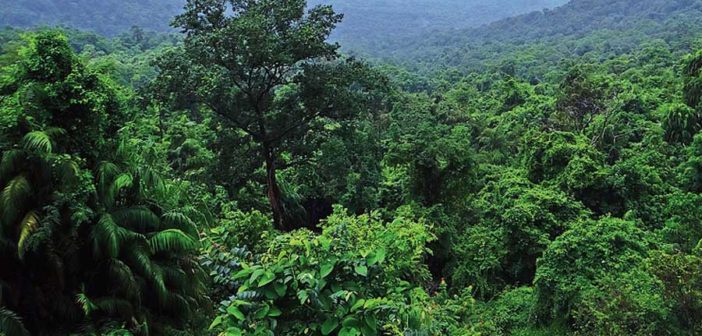Forest Survey of India data reveals that as of 2023, the Forest Cover in India constitutes about 22% of its geographical area, a marginal increase compared to 2021. Together, the Forest, Tree, and Scrub covers account for about 26% of India’s geographical area, leaving approximately 73% under non-forest cover.
The Environment Protection Act (EP Act) defines “Environment” as including “water, air and land and the inter-relationship which exists among and between water, air and land, and human beings, other living creatures, plants, micro-organism and property.”
Forests are integral and vital components of the environment, serving not only nature but also humanity in countless ways. Responding to the question on the significance of forests, Mita Sen of the UN Forum on Forests remarked in 2020, “it is difficult to picture life on Earth without forests and trees. Forests sustain our lives in so many ways, from the air we breathe and the water we drink to the food we eat and the wood and paper products that we use every day. Over 1.6 billion people depend on forests for timber, food, fuel, jobs, and shelter, but all of us depend on forests in one way or the other. Forests provide critical ecosystem services that affect our climate, rainfall patterns, and watersheds, at the same time they are also home to 80 percent of all land-based biodiversity”
Both the EP Act and the UN underscore a fundamental fact that human lives and all other forms of life are deeply intertwined with forests and trees. The UN further highlights that forests have the capacity to sequester four gigatons of carbon dioxide equivalent per year (GtCO2e/year), a vital function that can help bridge the gap in greenhouse gas (GHG) emissions. This underscores forests’ crucial role in achieving Sustainable Development Goals (SDGs) and limiting global warming to under 2°C.
In this story, we explore the trends in forest cover in India, as well as their status within the nation’s key ecosystems.
Data for this story is sourced from Dataful’s collection on Forest Cover in India, and India’s State of Forest Report, 2023, published by the Forest Survey of India (FSI).
Forest Cover in India is about 22% of Geographical area, against the envisaged objective of 33%
The National Forest Policy (NFP) of 1988, recognized the severe depletion of forests in India and underscored the urgent need for conservation. To address this, the NFP envisaged bringing 33% of the country’s Geographical Area (GA) under tree or forest cover. The FSI defines ‘Forest Cover’ as “All lands having trees spanning more than one hectare in area with a tree canopy density of more than 10%, irrespective of ownership, legal status of the land, or species composition of trees.”
As of 2023, FSI data reveals that the Forest Cover (FC) in India constitutes about 22% (7,15,343 square kilometres) of its GA of 3.27 million square kilometres (km2). Additionally, the areas under tree and scrub cover are 112,014 and 43,622 km2, respectively. Together, the Forest, Tree, and Scrub covers account for about 26% of India’s GA, leaving approximately 73% under non-forest cover.
It is important to note that the figures for FC include areas designated for compensatory afforestation to offset forest land diverted for non-forest purposes. However, compensatory afforestation often requires years, if not decades, to mature, and may not fully restore the ecological properties of the forests lost to non-forest uses.
Majority of the States do not have 33% of their GA under Forest Cover
Despite a marginal increase from 19% of GA under Forest Cover in 1987 to 22% in 2023, India’s forest cover remains significantly below the target of 33%. Analysing state-level data (excluding Union Territories (UTs), it is evident that most states have not achieved 33% forest cover during the period from 1987 to 2023. Only thirteen states have reached or surpassed this threshold at any point during this time. These states include the northeastern states of Arunachal Pradesh, Assam, Manipur, Meghalaya, Nagaland, Sikkim, and Tripura; the central state of Chhattisgarh; the western state of Goa; the eastern state of Odisha; the northern state of Uttarakhand; and the southern state of Kerala. Notably, these states are predominantly hilly or include ecologically sensitive areas such as the Western Ghats in Kerala. Conversely, other states that are not predominantly hilly have consistently fallen short of the 33% forest cover objective.
The combined GA of these twelve states is 6.49 lakh km² or about 20% of India’s total GA. Yet, as of 2023, their total forest cover accounts for approximately 46% (3.25 lakh km²) of the country’s total forest cover. In contrast, the remaining States/UTs, which collectively comprise about 80% of India’s GA, account for only 54% of the nation’s forest cover. Even when examined by recent years, all thirteen states except Odisha have consistently maintained forest cover at or above 33% from 2011 to 2023.
Regionally, the northeastern states, despite comprising only 8% of India’s GA, contribute approximately 24% of the country’s forest cover as of 2023.
Only 14% of Forest Cover has canopy cover of over 70%
The FSI also categorized forest cover data based on canopy density into three classifications. Canopy cover of 10-40%, 40%-70%, and over 70% are classified as Open Forests (OF), Moderately Dense Forests (MDF), and Very Dense Forests (VDF) respectively. By the same classification, as of 2023, the total area under OF, MDF, and VDF is 14% (102,502 km²), 43% (307,673 km²), and 43% (305,167 km²), respectively. This indicates that 86% of India’s total forest cover consists of forests with a canopy density below 70%.
Additionally, FSI data reveals that between 2011 and 2021, a total of 40,709 km2 or about 6% of total forest cover as of 2011 has changed from VDF and MDF to OF. Of this, 31646 km2 has degraded in the zero to ten hectares category, 5834 km2 in the 10 to 50 hectares category, and 3228 km2 from 50 and above hectares category. The top 3 states in zero to 10 hectares category forest cover changing from VDF and MDF to OF are Madhya Pradesh, Arunachal Pradesh, and Chhattisgarh with 4485 km2, 3723 km2, 2547 km2 respectively. In the 10 to 50 hectares category, the top 3 states are Odisha, Telangana, and Tamil Nadu, and for the 50 hectares & above category, it is Telangana, Odisha, and Tamil Nadu.
This underscores the fact that existing forests are losing canopy cover and becoming degraded. Apart from witnessing a slight increase in forest cover through means such as compensatory afforestation and others, the recent parliamentary reply dated 22 July 2024 revealed that India lost about 95,724 hectares (or 957 km2) for non-forest purposes between 2019 & 2024.
Between 2013 and 2023, Forest Cover increased in 6 hill states while it decreased in 9 hill states
As per FSI, 15 out of the 29 states in India are hill states, comprising a total of 172 hill districts. The FSI data indicates that between 2013 and 2023, the forest cover increased in states such as Himachal Pradesh, Karnataka, Kerala, Maharashtra, Sikkim, Tamil Nadu, and the UT of Jammu and Kashmir and Ladakh. However, during the same period, forest cover declined in several hill states, including Arunachal Pradesh, Assam, Manipur, Meghalaya, Mizoram, Nagaland, Tripura, Uttarakhand, and West Bengal. While the combined forest cover in these states showed a slight increase from 2,80,943 km² in 2013 to 2,83,713 km² in 2023, the number of states experiencing a decrease in forest cover is more than those showing an increase.
The NFP emphasizes that hill and mountain regions should maintain forest or tree cover over two-thirds of their area to prevent erosion, control land degradation, and ensure the stability of fragile ecosystems. Despite this objective, hill states like Assam, Uttarakhand, and West Bengal, with 36%, 45%, and 19% of their GA under forest cover as of 2023, have experienced reductions in forest cover over the past decade. This decline underscores the urgent need for afforestation efforts, particularly in the context of climate change challenges.
For example, a recent catastrophe in Wayanad district, where two villages were swept away by landslides, was partly attributed to deforestation. Furthermore, the latest atlas released by the Indian Space Research Organization (ISRO) highlighted that states like Uttarakhand are highly prone to landslides, underscoring the critical importance of increasing afforestation to mitigate such risks.
Between 2013 and 2023, Forest Cover in Western Ghats decreased in 4 states while it increased in 2 states
As per FSI, in 2013, the overall forest cover in 6 states, which are home to one of the United Nations recognized World’s Heritage Sites, the Western Ghats (WG), was 44,102 km2. By 2023, this has reduced to 44,043 km2. While the forest cover in WG in the states of Karnataka and Kerala has increased from 2013 to 2023, it has decreased in four other states, namely Goa, Gujarat, Maharashtra, and Tamil Nadu. Notably, 25 out of the total 45 districts among these states home to the Western Ghats have shown a decrease in forest cover, while the forest cover increased in the remaining 20 districts.
When the forest cover is compared by types of canopy cover, while the total VDF has increased from 5,046 km2 in 2013 to 8,511 km2 in 2023, the MDF, and OF have decreased by 25,750 to 24,707km2, and 13,306 to 10,826 km2, respectively, during the same period.



